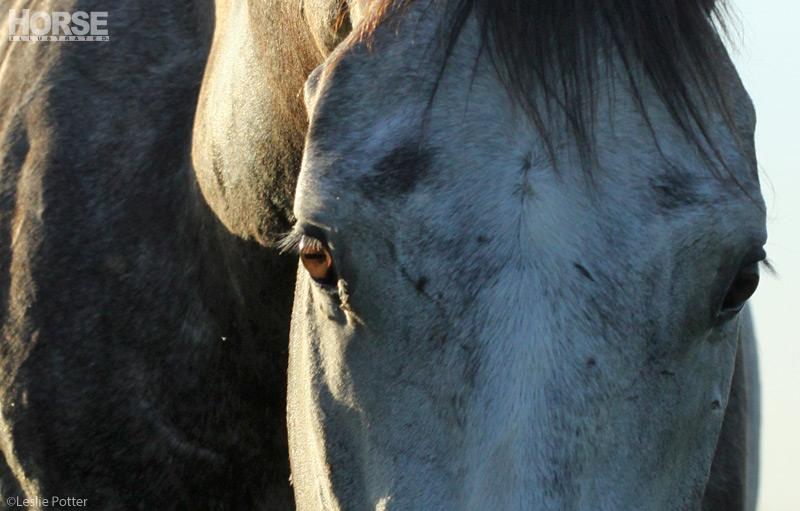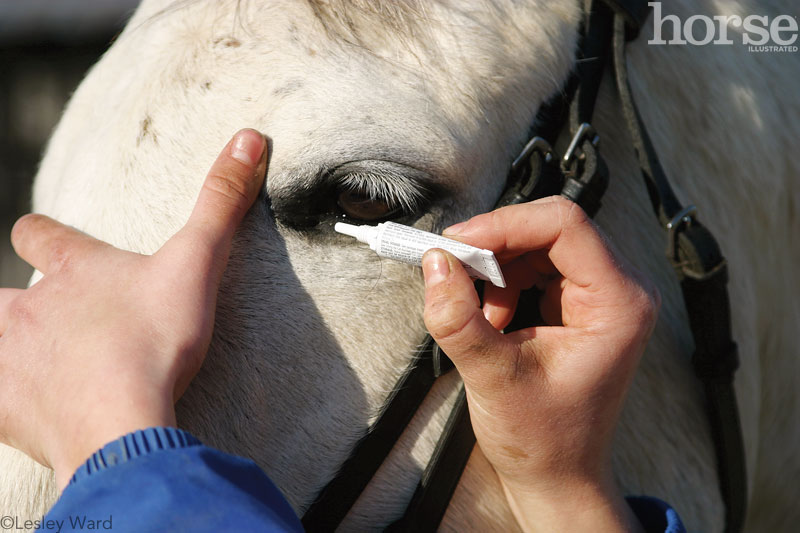
When horses itch, their only line of defense is to find a scratching post, and they’ll use anything that’s handy. “My nose itches. I guess I’ll have to rub it on the fence post. Oh, that itchy, sweaty feeling after a hard workout. There’s no human to rub on and knock down? The side of the barn will have to do.”
Do not “wait and see” with a possible eye injury—this is something we vets cannot emphasize enough. If your horse is rubbing his eye, or the eye looks swollen, half-shut, squinty, or is tearing or draining goo—call your vet for an appointment that day.
Treating a Horse Eye Injury
You might be thinking, “Oh, I’ve got some ointment in the tack room, and it is probably just an allergy that makes Frosty’s eye swell up and itch. I’ll put some of that in there and save paying the overpriced vet. In the end, she is going to try to sell me the same ointment I am going to use anyway.”
Many times you will be correct. With eye allergies, horses rub their eyes, which swell and itch due to some allergen that we almost never identify. You pollen sufferers will know what I am referring to. But remember that rubbing can also lead to corneal abrasions, punctures, lacerations, and those rascally foreign bodies in the eye.
Here is the punch line. That ointment you were going to put in Frosty’s eye has a steroid in it—hydrocortisone. The steroid reduces itching and inflammation, but in the case of a corneal injury, that steroid is the very worst thing you can put into your horse’s eye, and can even spell death to an eyeball. Steroids suppress the body’s ability to heal, thereby leaving it open to worse infection. The wrong treatment, as well as lack of treatment, can cost your horse’s vision.
Instead of attempting to treat the eye yourself, call the vet, who will likely diagnose the problem by administering a stain that turns fluorescent yellow-green. The stain diagnoses a disruption, a ding or a scratch in the clear window of the cornea. It does not stick to the smooth surface of intact corneal cells, but once that cornea has been disrupted or injured, the inner cells are exposed (like when you scratch your skin and bleed), and the stain will stick to it.
Three Steps to Healing a Horse Eye Injury
Pain: When a corneal wound is found, treatment should start by controlling your horse’s pain. What do we humans do when something hurts? We tend to rub it and fuss with it. Horses do the same thing. Rubbing the eye is the very last thing we want this horse to do, so you need to get the pain under control. Banamine is a good drug to use to control pain in this case. Your veterinarian might dispense Banamine granules or paste for you to administer. This will also help with swelling and inflammation, two maladies that usually come with the pain.

Antibiotics: A wound to the cornea is like an open wound anywhere else, except that it’s on an irreplaceable organ. Therefore, the eye is treated with antibiotics in order to stave off infection. Once infection has settled in, it’s more difficult to repair the eye—and certain bacterial invaders can cause devastating damage to a cornea.
Because the eye is self-washing with its tearing system, we need to frequently apply topical antibiotics to the eye itself. This can be a daunting task for a horse owner, particularly if the patient is not cooperative. In the worst-case scenario, small catheters can be placed beneath the horse’s eyelid and liquid antibiotics can be delivered through them. However, this is generally reserved for the toughest cases.
The pupil: The pupil is the opening in the middle of the iris that lets light into the eye and makes vision possible. In situations of pain and trauma to an eye, the pupil will constrict, like yours does when you look directly into a light. When there is a lot of inflammation, as in the case of an eye injury or infection, the pupil can get stuck in its constricted, or more closed, position. In this case, vets will usually administer something like atropine to dilate the pupil until the eye heals and everything settles down. It is important to provide your horse with shade while he is being treated for an eye problem; keeping him in the stall is likely best because you are going to be treating your horse multiple times a day.
There are many things that can happen to horses’ eyes. Equine recurrent uveitis, or “moon blindness,” is a disease that plagues some horses. Horses can dislodge their lenses. They can suffer with conjunctivitis or a myriad of other things. While the majority of vet calls are for the “allergic eye,” or the eye with some sort of corneal wound, only your vet can determine the cause.
At the first sign your horse’s eye is irritated and itchy—swelling, redness, excessive tearing, rubbing—call your vet for a diagnosis. If it turns out to be allergies and not a corneal injury, it is important to come up with a plan for controlling your horse’s itchiness before he hurts himself. It will save countless troubles and dollars in the long run—and it might just save your horse’s eye. Take it from a veterinarian who has a mare named Sylvia: In the beginning she had two eyes. Today, she only has one. If it can happen to my horse, it can happen to yours.
The Eye Care Oath
I do solemnly swear …
To phone my veterinarian before putting goop of any sort into my horse’s eye.
I also solemnly swear to have all the eye goop from the tack room on hand when I phone my vet so I can read the label to the vet to see if it is OK to put into my horse’s eye. And to be wearing my glasses when I phone so I can actually read the small print.
I do solemnly swear …
That I will never ignore an itchy, swollen, teary or gooey eye; at least not one attached to my horse … my spouse, on the other hand …
And I will phone the very same day I notice a problem with my horse’s eye.
Amen.
In fact, it might not be a bad idea to post the Eye Care Oath on the barn wall next to the telephone where you keep your vet’s number and the number of the person who hauls horses in case of emergency. The hauling suggestion has nothing to do with eyes. It is just that nobody ever seems to know how to have their horse moved when there is a dire need for moving said horse.
DR. RILEY is a semi-retired large animal vet who writes from her riverside cabin in Great Cacapon, W.Va.
This article originally appeared in the February 2015 issue of Horse Illustrated magazine. Click here to subscribe!






My horse has injured his eye 3 times in two years. Stitches each time. No other injury. What can I do to relief his itch? Thanks for the great information
I am currently treating my mare three times a day for this very thing. Ulcers in both eyes. Started treating 6 days ago. Making progress
Fly mask help keep fly issues out of the eyes, if only the horses knew we were trying to help them.